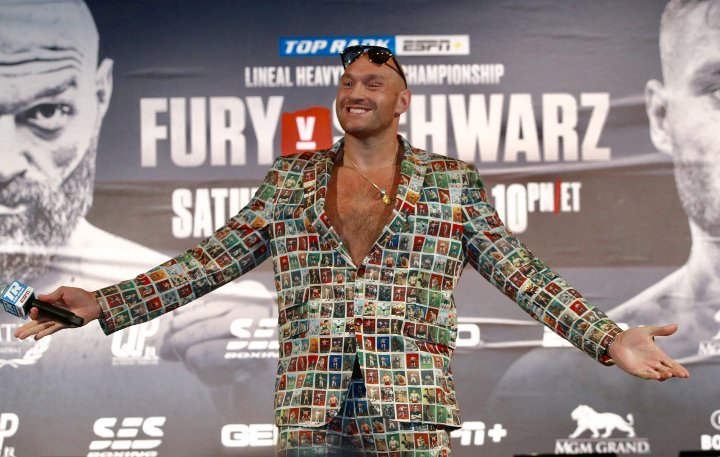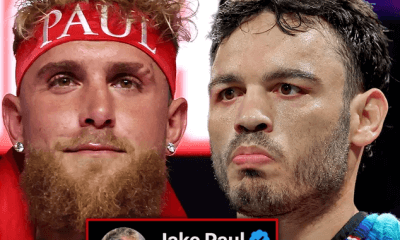Featured Articles
The Avila Perspective, Chap 51: Tyson Fury and More

Over the past 100 years it’s apparent that heavyweights are indeed a different breed when it comes to prizefighting. Heavyweights come in all shapes and sizes and it’s been proven that when it comes down to fighting, certain styles can beat other certain styles. Great Britain’s Tyson Fury (27-0-1, 19 KOs) brings a unique blend that will be in display against Germany’s Tom Schwarz (24-0, 16 KOs) on Saturday, June 15, at the MGM Grand in Las Vegas. ESPN+ will show the fight.
Their bout represents the lineal world championship, a designation that refers to the ability to trace the true owner of the original world title going back to the great John L. Sullivan in the 1890s. In this world of multiple world title belts it has merit.
“The only title that I care about is the lineal championship of the world. It goes back a long, long way, and that’s the one I’m defending with pride and honor,” says Fury, the owner of the lineal championship.
Fury presents one giant of a problem for any heavyweight who opposes him. First, he is nearly seven-feet tall. Second, he has the mobility of a welterweight. And third, he can deliver a knockout if necessary.
In the past there has been one seven-foot giant heavyweight champion. Remember Nicolai Valuev?
Who would have imagined that the giant Valuev would lose to the much smaller David Haye? But it happened.
It call comes down to styles and it has always been that way going all the way back to the early 1900s.
Jack Johnson
When Jack Johnson became the first Black heavyweight champion of the world in 1908 by defeating Tommy Burns in Australia, boxing promoters scoured the world in search of a heavyweight who could defeat him. Eventually promoters discovered giant Jess Willard who won by suspicious knockout in Round 26 in Havana, Cuba.
The 6’7″ Willard fought once more before he was toppled in humiliating fashion by the much smaller Jack Dempsey. Seven times he was floored by the relentless Dempsey and pummeled into a bloody mess. It was another example of styles suiting certain styles and the faster hands of Dempsey proving to be too much for the bigger lumbering heavyweight Willard.
Dempsey was subsequently defeated by a light heavyweight Gene Tunney whose hit and move style flummoxed the hard-charging Dempsey. It’s a vicious circle in heavyweight boxing that keeps going round and round.
Enter Andy “The Destroyer” Ruiz the first Chicano heavyweight title-holder who recently knocked out the other British heavyweight Anthony Joshua. Those stubby but fast hands of the much shorter Ruiz proved too much for the athletic giant Joshua.
Now, we have Fury who seems to be a hybrid heavyweight with size, speed, agility and with a touch of power. Though he managed a draw against the wild punching WBC heavyweight titlist Deontay Wilder, will he be able to showcase those same skills against the German-style heavyweight Schwarz?
“I take inspiration from German heavyweights of the past, including Max Schmeling. It might be time for a German heavyweight to shock the world again,” said Schwarz about the fight that took place in the 1930s that saw Schmeling knock out the heavily-favored Joe Louis. “We’ve analyzed his style and have prepared our best strategy. I have a surprise for Tyson Fury, and he will see what it is on Saturday night.”
Uh oh. I see something.
Thursday in Hollywood, Ca.
Golden Boy Promotions stages a short but powerful fight card featuring super bantamweight contender Azat Hovhannisyan and WBC Silver light flyweight titlist Seniesa Estrada in co-main events at the Avalon Theater in Hollywood, Calif. DAZN will stream the Thursday night boxing card.
Hovhannisyan (16-3) meets Glenn Porras (32-8) in a 10 round super bantamweight clash.
East L.A.’s Estrada (16-0, 6 KOs) defends the light flyweight title against Philippine’s Gretchen Abaniel (18-10). Estrada has a four-fight knockout streak.
Doors open at 4:30 p.m.
Thursday in OC
In Costa Mesa, Calif. Roy Englebrecht Events stages a boxing and MMA fight card at the OC Hangar on Thursday June 13. It’s the 50th show at this location and will be celebrated with 50 cent hot dogs and 50 cent drinks. The main event features Triantafyllos Mavidis (5-0) versus Derrick Findley (32-25-1) in an eight round super middleweight clash. Doors open at 6:30 p.m.
Friday in Ontario, Calif.
Thompson Boxing Promotions presents another boxing card, this one features undefeated super welterweight Richard Brewart (5-0) versus Antonio Duarte (2-0) in a six round main event Friday June 14, at the Doubletree Hotel in Ontario.
Brewart, 20, is a sharp punching boxer-puncher from Rancho Cucamonga who is making his fifth appearance at the Doubletree Hotel. He is trained by Henry Ramirez, the former trainer of Chris Arreola and Josesito Lopez.
Also on the card will be heavyweight hopeful Oscar Torrez (5-0) meeting Siala Siligia (2-2) in a four round clash. Torrez is also trained by Henry Ramirez and fights out of Rialto, Calif. Doors open at 7 p.m. and the first bout starts at 8 p.m. Fans can also watch it live stream on Thompson Boxing Promotion’s Facebook.com page.
WBC Cares
The WBC’s 5th annual Green Belt Challenge amateur tournament takes place beginning Thursday June 13, at South El Monte High School in South El Monte, Calif. The three-day event begins at Thursday with weigh-ins at 3 p.m. and fights at 6 p.m. On Friday the same start times are kept. Saturday’s event begins at 8 a.m. with bouts starting at 1 p.m.
Among the sponsors are Teiken Promotions, Golden Boy Promotions and Nakornloung. Oscar De La Hoya will be among many of the celebrities expected to attend the event, a list including Mercito Gesta, Mikey Garcia, Maricela Cornejo and Sulem Urbina.
Here is the link for information on the event: https://wbcboxing.com/en/wbc-amateur-green-belt-challenge/
Check out more boxing news on video at The Boxing Channel
To comment on this story in The Fight Forum CLICK HERE
-

 Featured Articles4 weeks ago
Featured Articles4 weeks agoAvila Perspective, Chap. 330: Matchroom in New York plus the Latest on Canelo-Crawford
-

 Featured Articles3 weeks ago
Featured Articles3 weeks agoVito Mielnicki Jr Whitewashes Kamil Gardzielik Before the Home Folks in Newark
-

 Featured Articles12 hours ago
Featured Articles12 hours agoResults and Recaps from New York Where Taylor Edged Serrano Once Again
-

 Featured Articles4 weeks ago
Featured Articles4 weeks agoCatching Up with Clay Moyle Who Talks About His Massive Collection of Boxing Books
-

 Featured Articles5 days ago
Featured Articles5 days agoFrom a Sympathetic Figure to a Pariah: The Travails of Julio Cesar Chavez Jr
-

 Featured Articles3 weeks ago
Featured Articles3 weeks agoMore Medals for Hawaii’s Patricio Family at the USA Boxing Summer Festival
-

 Featured Articles7 days ago
Featured Articles7 days agoCatterall vs Eubank Ends Prematurely; Catterall Wins a Technical Decision
-

 Featured Articles4 weeks ago
Featured Articles4 weeks agoRichardson Hitchins Batters and Stops George Kambosos at Madison Square Garden




















